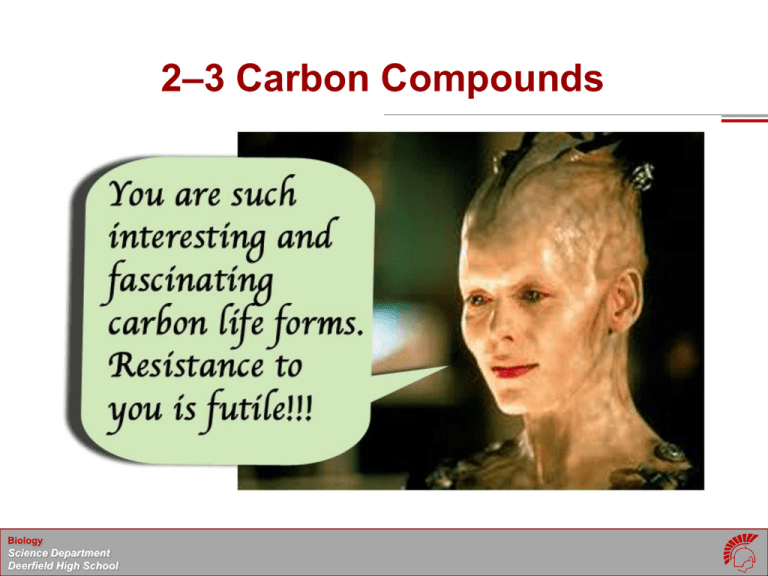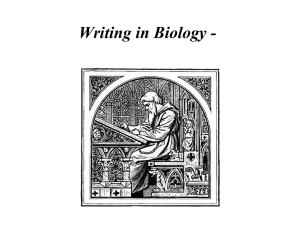
2–3 Carbon Compounds
QuickTime™ and a
decompressor
are needed to see this picture.
Biology
Science Department
Deerfield High School
Copyright Pearson Prentice Hall
The Chemistry of Carbon
Carbon is found in all living organisms.
Carbon atoms can bond with hydrogen, oxygen, nitrogen, sulfur,
and phosphorus to form carbon or organic compounds.
Carbon or organic compounds are the building blocks for
organisms and the major source of their chemical energy.
CARBON COMPOUNDS = ORGANIC COMPOUNDS!
Biology
Science Department
Deerfield High School
Copyright Pearson Prentice Hall
Why do I need to know about carbon
compounds?
Life depends on carbon/organic
compounds! When you eat food or
inhale oxygen, your body uses
these materials in chemical
reactions that keep you alive.
Just as buildings are made from
bricks, steel, glass and wood, living
things are made from
carbon/organic compounds.
Biology
Science Department
Deerfield High School
Why is CARBON so important?
Carbon atoms have the ability to form strong bonds.
Not only can carbon atoms bond to H, N, O, P and S
atoms, but a carbon atom can bond to other carbon
atoms!
-this gives carbon the ability to form long chains
-the carbon-carbon bonds can be single, double,
or triple covalent bonds
-chains of carbon atoms can close and form rings
This makes carbon a versatile element-No other element even comes close!
Biology
Science Department
Deerfield High School
Macromolecules
Carbon/organic compounds are
Macromolecules--mega molecules.
Macromolecules are formed by a
process known as
polymerization, where smaller
molecules, monomers, join
together to form larger molecules,
polymers.
Biology
Science Department
Deerfield High School
Copyright Pearson Prentice Hall
Macromolecules
Four groups of carbon/organic compounds are
found in living organisms:
– carbohydrates
– lipids
– nucleic acids
– proteins
Biology
Science Department
Deerfield High School
Copyright Pearson Prentice Hall
Borg like me
you would not
need carbonbased molecules!
All living organisms contain
carbohydrates, lipids, proteins,
and nucleic acids. In order to
make these molecules, all
consumers must eat plants
and animals. These foods
provide consumers with the
materials they need to make
their own carbon-base molecules.
Biology
Science Department
Deerfield High School
Copyright Pearson Prentice Hall
What is a Carbohydrate?
Biology
Science Department
Deerfield High School
Carbohydrates – Structure
A carbohydrate is an organic
compound made up of carbon,
hydrogen and oxygen.
Carbohydrate macromolecules have
a unique ring structure.
The building blocks of carbohydrates
are monosaccharides, like glucose.
C6H12O6
Biology
Science Department
Deerfield High School
Carbohydrates – Structure
The various forms of carbohydrate polymers
are…
monosaccharide: single sugar molecule
(Ex: glucose, galactose, fructose)
disaccharide: two sugar molecules
(Ex: lactose, sucrose)
polysaccharide: many sugar molecules
(Ex: glycogen (in animals)
starch, cellulose (in plants))
Biology
Science Department
Deerfield High School
Polysaccharide: Glycogen
A storage form of sugar in animals
(mainly mammals) in the liver and
muscles.
Ex: When your blood
glucose levels are
low, glycogen is
released from the liver.
Biology
Science Department
Deerfield High School
Polysaccharide: Starch
A storage form of sugar in plants in
food reservoirs such as seeds and
bulbs.
Ex: potatoes, cereal,
pasta, bread, rice
Biology
Science Department
Deerfield High School
Polysaccharide: Cellulose
Used for strength and rigidity in
plants in the cell wall.
Cellulose is an indigestible molecule,
also known as fiber.
Ex: vegetables, fruits,
wood and paper
Biology
Science Department
Deerfield High School
Carbohydrates – Function
Living things use carbohydrates as their
main source of energy.
Simple sugars (mono-, di- saccharides)
provide immediate energy for all cell
activities.
Living things store extra sugar as
complex carbs (polysaccharides).
Biology
Science Department
Deerfield High School
What is a Lipid?
Biology
Science Department
Deerfield High School
Lipids – Structure
A lipid is a macromolecule
made up of mostly carbon
and hydrogen atoms.
Lipids are unique because
they are nonpolar
molecules, meaning they do
NOT dissolve in water.
Lipid macromolecules are
chain structures.
The building blocks of lipids
are fatty acids.
Biology
Science Department
Deerfield High School
Lipids – Structure
The various forms of polymer lipids
are…
saturated fatty acid (“full”):
contain the maximum number of hydrogen atoms;
carbon atoms joined by single bonds
unsaturated fatty acid (“not full”):
do NOT contain the maximum number of hydrogen
atoms; carbon atoms joined by double bonds
Biology
Science Department
Deerfield High School
Lipids – Structure
Biology
Science Department
Deerfield High School
Unsaturated fats
Many unsaturated fats are found in
vegetable products, fish, and
Are LIQUID at room temperature
Ex: plant oils, nuts,
fish oil
Biology
Science Department
Deerfield High School
Saturated fats
Many saturated fats are found in animal
products, and
Are SOLID at room temperature
Ex: butter, fats
in meats
Biology
Science Department
Deerfield High School
Trans fats
Trans fats are man-made (artificial); this is
done by “hydrogenating vegetable oils”
They are SOLID at room temperature
Ex: many
processed
foods
Biology
Science Department
Deerfield High School
Lipids – Function
The main functions of lipids are for
energy storage
insulation
make up cell membranes
protective waterproof coverings
Biology
Science Department
Deerfield High School
What is a Protein?
Biology
Science Department
Deerfield High School
Proteins – Structure
A protein is a large complex polymer made
up of carbon, hydrogen, oxygen and
nitrogen.
Protein macromolecules are very
large,complex, and unique structures.
The building blocks of proteins are amino
acids.
Biology
Science Department
Deerfield High School
Proteins – Structure
For each amino acid…
the amino & carboxyl
groups are identical so
they can join together by
covalent bonds, but
the “R” group is
different.
There are 20 common
amino acids used by all
organisms in nature, in
different combinations.
Biology
Science Department
Deerfield High School
Proteins – Function
The function of proteins include:
control the rate of chemical reactions enzymes
regulate cell processes
transport oxygen in the blood hemoglobin
help fight disease - antibodies
form bone and muscle
Biology
Science Department
Deerfield High School
The instructions for arranging amino acids into
many different proteins are stored in DNA.
Protein Molecule
Amino
Acids
Biology
Science Department
Deerfield High School
Copyright Pearson Prentice Hall
What is a Nucleic Acid?
Biology
Science Department
Deerfield High School
Nucleic Acids – Structure
A nucleic acid is also a polymer made up of
carbon, hydrogen, oxygen, nitrogen and
phosphorus.
Nucleic acid macromolecules vary in their
size and complexity: DNA is a long double
helix!
The building blocks of nucleic acids are
monomers known as nucleotides.
Biology
Science Department
Deerfield High School
Nucleic Acids – Function
The main function of
nucleic acids is to store
and transmit genetic
(hereditary) information.
There are 2 kinds:
RNA (ribonucleic acid)
DNA (deoxyribonucleic acid)
Biology
Science Department
Deerfield High School
2–3
Large carbohydrate molecules such as
starch are known as
–
–
–
–
lipids.
monosaccharides.
proteins.
polysaccharides.
Biology
Science Department
Deerfield High School
Copyright Pearson Prentice Hall
2–3
Many lipids are formed from glycerol and
–
–
–
–
fatty acids.
monosaccharides.
amino acids.
nucleic acids.
Biology
Science Department
Deerfield High School
Copyright Pearson Prentice Hall
2–3
Proteins are among the most diverse
macromolecules because
– they contain both amino groups and carboxyl
groups.
– they can twist and fold into many different and
complex structures.
– they contain nitrogen as well as carbon, hydrogen,
and oxygen.
– their R groups can be either acidic or basic.
Biology
Science Department
Deerfield High School
Copyright Pearson Prentice Hall
2–3
Which of the following statements about
cellulose is true?
– Animals make it and use it to store energy.
– Plants make it and use it to store energy.
– Animals make it and use it as part of the
skeleton.
– Plants make it and use it to give structural
support to cells.
Biology
Science Department
Deerfield High School
Copyright Pearson Prentice Hall
2–3
A major difference between polysaccharides and
proteins is that
– plants make polysaccharides, while animals make
proteins.
– proteins are made of monomers, while
polysaccharides are not.
– polysaccharides are made of monosaccharides,
while proteins are made of amino acids.
– proteins carry genetic information, while
polysaccharides do not.
Biology
Science Department
Deerfield High School
Copyright Pearson Prentice Hall










